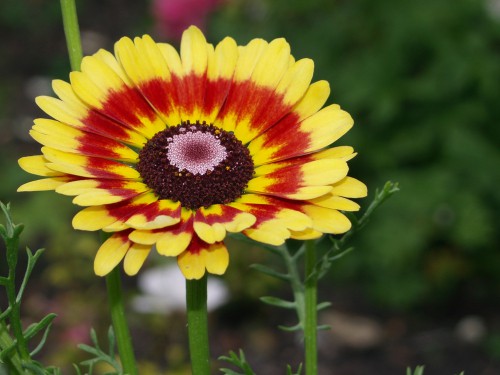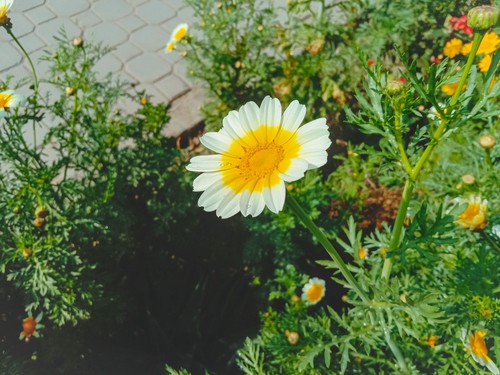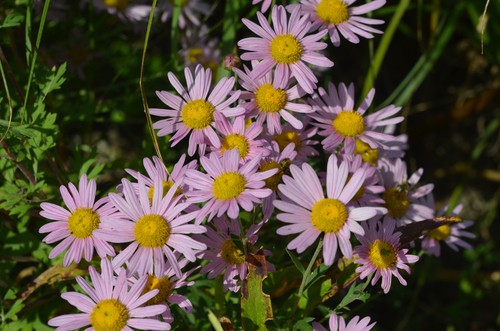Last updated on November 2nd, 2021
Our site is reader supported, this means we may earn a small commission from Amazon and other affiliates when you buy through links on our site.
This simple question has quite a complicated answer. Some chrysanthemums (also known as mums) are bred as annuals and others are developed to be perennials. But, if you’re careful, you can overwinter annual mums and grow them again the following year, effectively changing them into perennials. We discuss each type, with examples.
Annual garden mums
Most people grow mums in pots and treat them as annuals; that is, they discard them at the end of the growing season. The most popular use of chrysanthemums is as a shot of colour in the garden or in your house during autumn and early winter. Placing a fully grown mum in a pot on your patio brings instant colour to a garden that’s otherwise winding down in colour and shades of green.
Most garden mum plants are hardy annuals and, in milder climates without too much snowfall or too many frost days, can handle temperatures down to around -5°C.
Some popular annual mums are:
Painted Lady (Chrysanthemum carinatum)

- Bushy and compact; grows to 60cm tall.
- Single flowers; purple centres surrounded by bands of different colours.
- Varieties to look for: Sunset (reds, yellows and oranges) and Polar Star (yellow centre band and white flower).
- Sow on the surface of fine seed compost from late winter to early summer indoors or heated under-cover. Germination takes 5-21 days at 18-24C (65-75F).
- Transplant when large enough to handle into trays and grow on. Gradually acclimatise to outdoor conditions for 10-15 days and plant out when all danger of frost has passed.
- Prefers well drained soil in full sun.
- Professional DEFRA licenced Quality Seed Supply only - Minimal packaging - Ziplock labelled bags - Instructions not attached - See details provided above for cultivation advice.
Read next: When do chrysanthemums flower?
Crown Daisy

- Hardy annual; grows to 45cm high.
- Double, semi-double or single flowers in white to golden-yellow.
- Fern-like foliage.
- Varieties to look for: Golden Gem (single blooms, orange eye and yellow surround) and Primo (double blooms in cream and yellow).
No products found.
Perennials garden mums
Perennial mums are developed to be hardy and come back every year. These mums are usually grown in garden beds, though you can grow them outside in pots. To give your perennial chrysanthemum the best chance of survival, plant it in spring rather than autumn.
As most mums are for sale in the autumn, you have to search out those available in the spring or use an annual plant that you’ve over-wintered successfully. For the best results, look for perennials that are described as ‘hardy’ rather than ‘tender’.
There’s a wide selection of perennial mums including:
Korean Chrysanthemum hybrids (Chrysanthemum rubellum)

- Hardy perennials that spread widely and form clumps.
- Grow up to 60cm tall and 45cm wide.
- Flowers are pink or red and look a bit like daisies; also come in yellow and apricot coloured cultivars.
- Leaves are lobed.
Chrysanthemum ‘Double American Spray’
- Half-hardy perennial so needs a bit of extra care during winter.
- Flowers are in sprays and in hues of bronze, yellow, pink and white.
- Grows 75cm tall and 45cm wide.
Making annual mums into perennials
Successfully turning annual mums into perennials is about three things: when you plant them; how hardy the plant is; and over-wintering them.
When to plant mums?

Perennial mums work best as an integral part of your garden in the soil, whether in flower borders or in a bed by themselves. As with perennial chrysanthemums, the best time to plant annual mums that you want to transition into perennials is in the spring. As I mention above, you either have to search out an annual mum for sale or, better, perhaps you’ve over-wintered a potted annual plant from the previous year.
Planting the annual mum in the spring gives the bush time to establish its roots before it has to divert all its energy and effort to form the blooms. Planting in the autumn means that the plant’s energy is spread between root formation and keeping the flowers looking great, and neither develops fully.
Read next: What are the different types of chrysanthemums?
How hardy is the annual mum?
The varieties that are marketed as ‘garden mums’ are generally hardier and have the best chance of becoming perennials. If you’ve bought the mum from a florist, chances are that it’s not a variety of garden mum and so is not very hardy. It may not survive in the garden.
If you’re using your own over-wintered annual plant, and it’s looking healthy and even has a green shoot or two, you’re good to go.
The best way to decide is just to try it and see.
How to overwinter chrysanthemums successfully
We have a complete article about how to overwinter chrysanthemums, as there’s not enough room here. We cover keeping the plants in the garden and also how to store them elsewhere.
So, that’s the complicated answer to the annual vs perennial question for mums.
If you want some guidance for looking for the correct type of mums for your garden, check out our The different types of chrysanthemums article. And for the basics of growing potted mums, the Growing chrysanthemums in pots and containers article is invaluable.
Last update on 2025-04-12 / Affiliate links / Images from Amazon Product Advertising API



